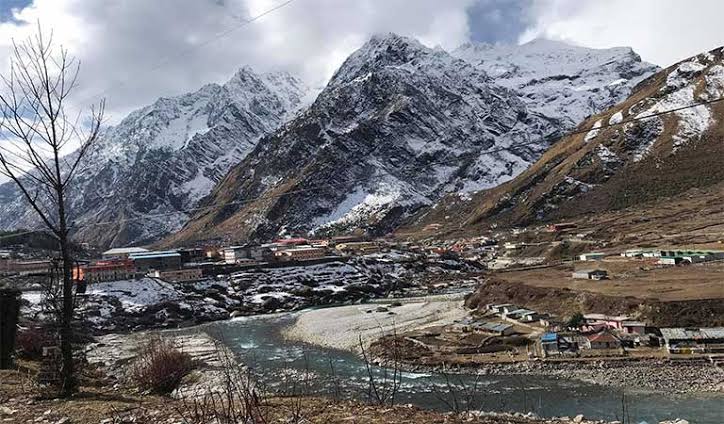Introduction to Mana Valley.
Nestled in the lap of the Garhwal Himalayas, Mana Valley is more than just a travel destination—it’s a spiritual and cultural journey. Often hailed as the “Gateway to Heaven”, the valley beautifully blends mythology, spirituality, and natural wonders.
The valley begins at the revered Badrinath Temple and extends up to the stunning Vasudhara Falls. Along the way, you encounter sacred footprints, ancient legends, roaring rivers, and a village that proudly holds the title of India’s first village on the Indo-Tibet border.
Whether you’re a pilgrim seeking divine energy, a trekker chasing Himalayan trails, or a traveler yearning for peace, Mana Valley is an experience that lingers forever.
Badrinath: The Spiritual Beginning.
The journey to Mana Valley starts at Badrinath, one of the holiest shrines of Hinduism and a crucial stop on the Char Dham Yatra.
- The Badrinath Temple, dedicated to Lord Vishnu, stands magnificently at 10,000 feet above sea level.
- Beside the temple flows the sacred Alaknanda River, offering soul-stirring views.
- Before entering the shrine, pilgrims take a holy dip in Tapt Kund, a natural hot spring that remains warm (40–45°C) despite the freezing Himalayan winds.
The serene chants, snow-clad peaks, and the fragrance of incense set the perfect spiritual tone for the Mana Valley expedition.
Charan Paduka: Sacred Footprints of the Divine.
A 3 km uphill trek from Badrinath takes you to Charan Paduka, a boulder believed to carry the footprints of Lord Krishna.
On the way, you witness:
- The Neelkanth Glacier sparkling under the sun.
- Waterfalls cascading down the cliffs.
- Himalayan peaks playing hide-and-seek with clouds.
Locals believe Lord Krishna once rested here, leaving his divine footprints behind. Sadhus often set up small shelters along the route, serving herbal tea and narrating stories from scriptures, making this trek both enchanting and enlightening.
Jagirdar Homestay: A Heritage Retreat.
For travelers seeking both comfort and heritage, Jagirdar Homestay offers an unforgettable stay.
- Located just 150 meters from Badrinath Temple.
- This century-old bungalow overlooks the valley and has hosted Garhwal royals and even Dr. Rajendra Prasad, India’s first president.
- Its rustic charm, combined with local hospitality, gives you a sense of living in history while being surrounded by Himalayan grandeur.
Mana Village: India’s First Village.
Just 3 km from Badrinath lies Mana Village, known as India’s first village. Situated near the confluence of the Alaknanda and Saraswati rivers, it is a gem of Himalayan culture and mythology.
Highlights of Mana Village:
- Seasonal settlement of locals, mostly weavers and shepherds.
- Famous for handmade woolens and traditional Himalayan herbs.
- Mythology links it to the Pandavas, who began their journey to heaven (Swargarohini) from here.
- Acts as the base camp for the Satopanth trek, which leads to the glacial lake considered sacred to Lord Vishnu.
Walking through the village, you feel as if you are traveling back in time—stone houses, narrow lanes, and tales of Mahabharata whispered in the winds.
Bhimpul: Bridge of Legends.
One of Mana Valley’s most iconic spots is Bhimpul, a colossal rock bridge across the Saraswati River.
- Legend says Bhima (one of the Pandava brothers) placed this rock here to help his family cross the gushing river on their way to heaven.
- The sight of the roaring Saraswati forcing its way under the rock is breathtaking.
- Today, it stands as both a natural marvel and a mythological monument.
Trek to Vasudhara Falls.
The most mesmerizing part of Mana Valley is the trek to Vasudhara Falls.
- Distance: 8 km from Mana Village
- Height: 122 meters (one of Uttarakhand’s tallest waterfalls)
- Mythology: The Pandavas are believed to have rested here before their final ascent to heaven.
The trail takes you through high-altitude landscapes, silent valleys, and snow-kissed cliffs. Local belief says the water from Vasudhara Falls only touches those with a pure heart, making the trek spiritually significant as well as visually rewarding.
The mist rising from the waterfall, the echo of the river, and the surrounding snow peaks make it feel like you’ve stepped into another realm.
Best Time to Visit Mana Valley.
- May to June – Pleasant weather, perfect for trekking and temple visits.
- September to October – Crisp skies, best views of the Himalayas.
- Winter (Nov–April) – The entire valley, including Badrinath and Mana, remains closed due to heavy snowfall.
Suggested Itinerary for Mana Valley (3 Days).
Day 1: Arrive in Badrinath → Visit Badrinath Temple & Tapt Kund → Overnight stay.
Day 2: Trek to Charan Paduka → Explore Mana Village → Visit Bhimpul → Evening by Saraswati River.
Day 3: Trek to Vasudhara Falls → Return to Badrinath → Departure.
Conclusion: The True Gateway to Heaven.
Mana Valley is not just a destination—it is an awakening for the soul. From the divine aura of Badrinath, the heritage of Jagirdar Homestay, the legends of Mana Village, to the serene trek of Vasudhara Falls, every step connects you deeper with both mythology and nature.
It is rightly called the “Gateway to Heaven” because here, the spiritual and the earthly merge seamlessly, leaving you transformed forever.
Best Video: To Know More About Mana Valley.
This Video Belong’s To TRAVEL BUG Named Youtube Chanel.
FAQs About Mana Valley
How far is Vasudhara Falls from Mana Village?
It is an 8 km trek from Mana Village.
Is Mana Village really the first village of India?
Yes, it is officially known as India’s first village, located on the Indo-Tibet border.
Best time to visit Mana Valley?
May–June and September–October are the best months to visit.
Where is Mana Valley located?
Mana Valley is in Chamoli district, Uttarakhan, close to the Indo-Tibet border and near Badrinath.
Why is Mana Valley called the “Gateway to Heaven”?
According to the Mahabharata, the Pandavas started their journey to heaven (Swargarohini) from here.

